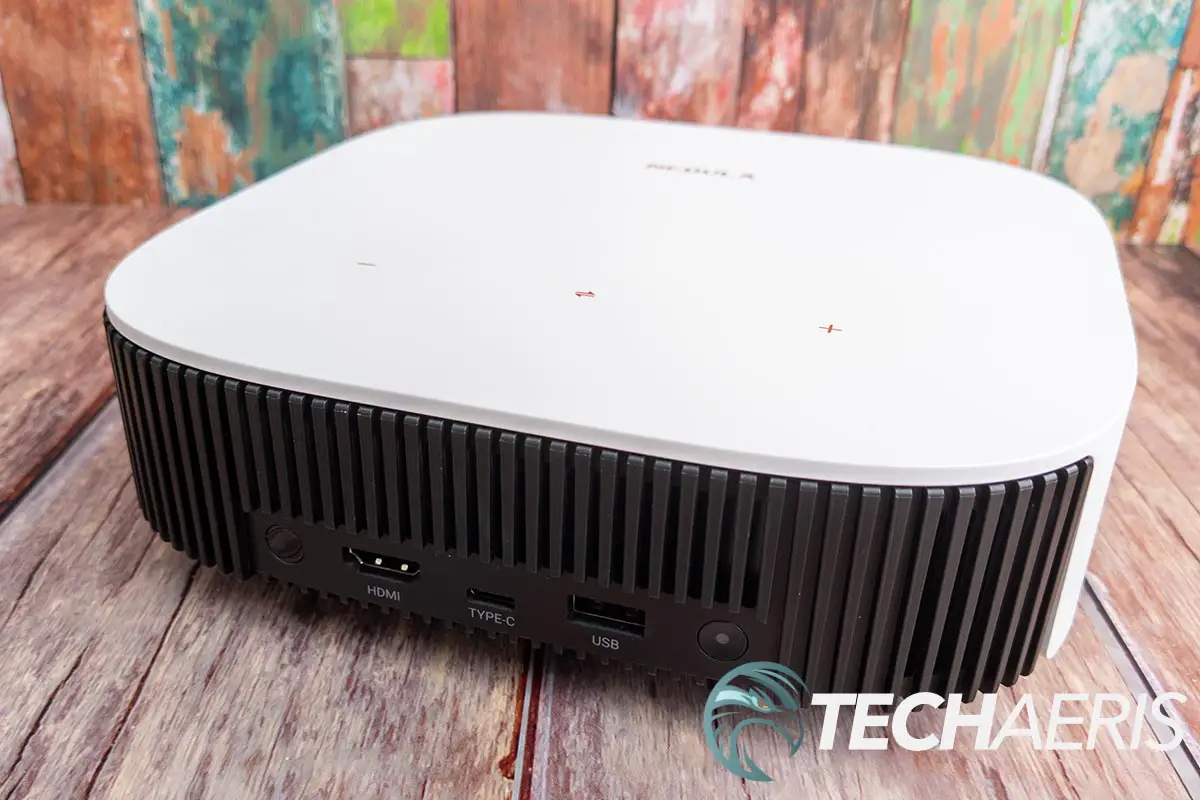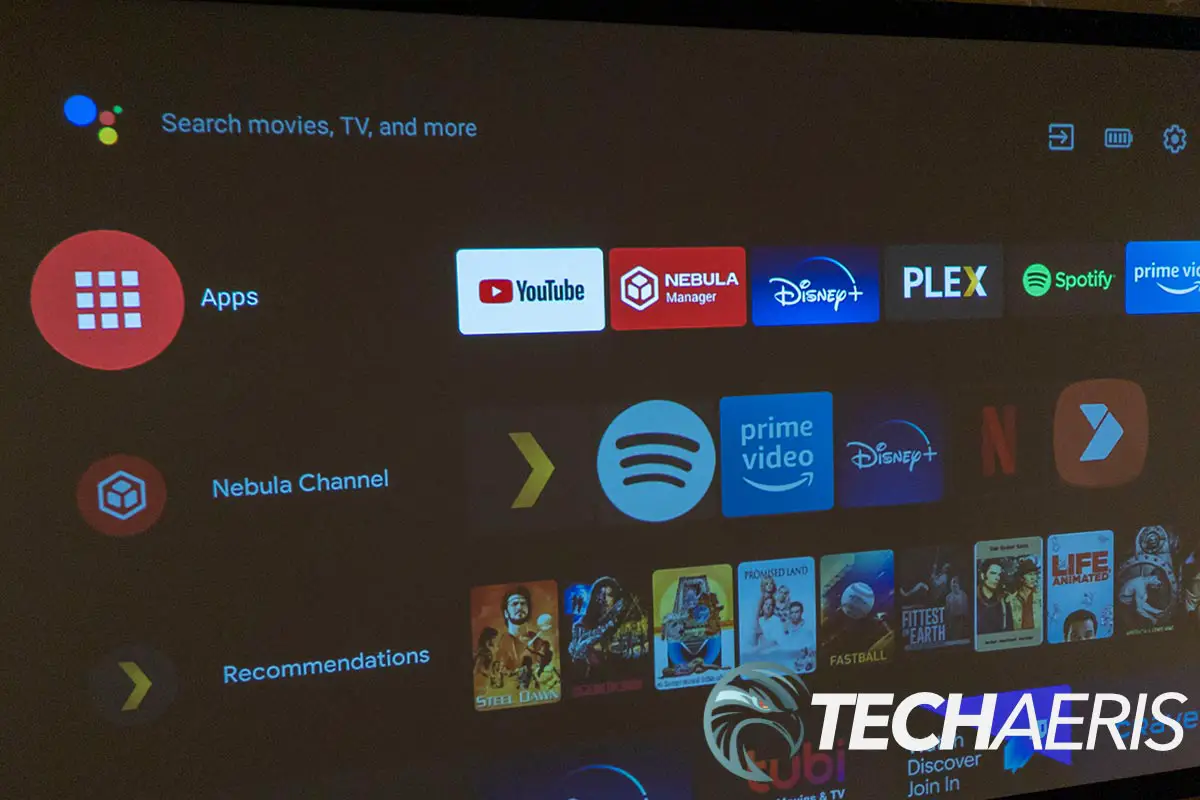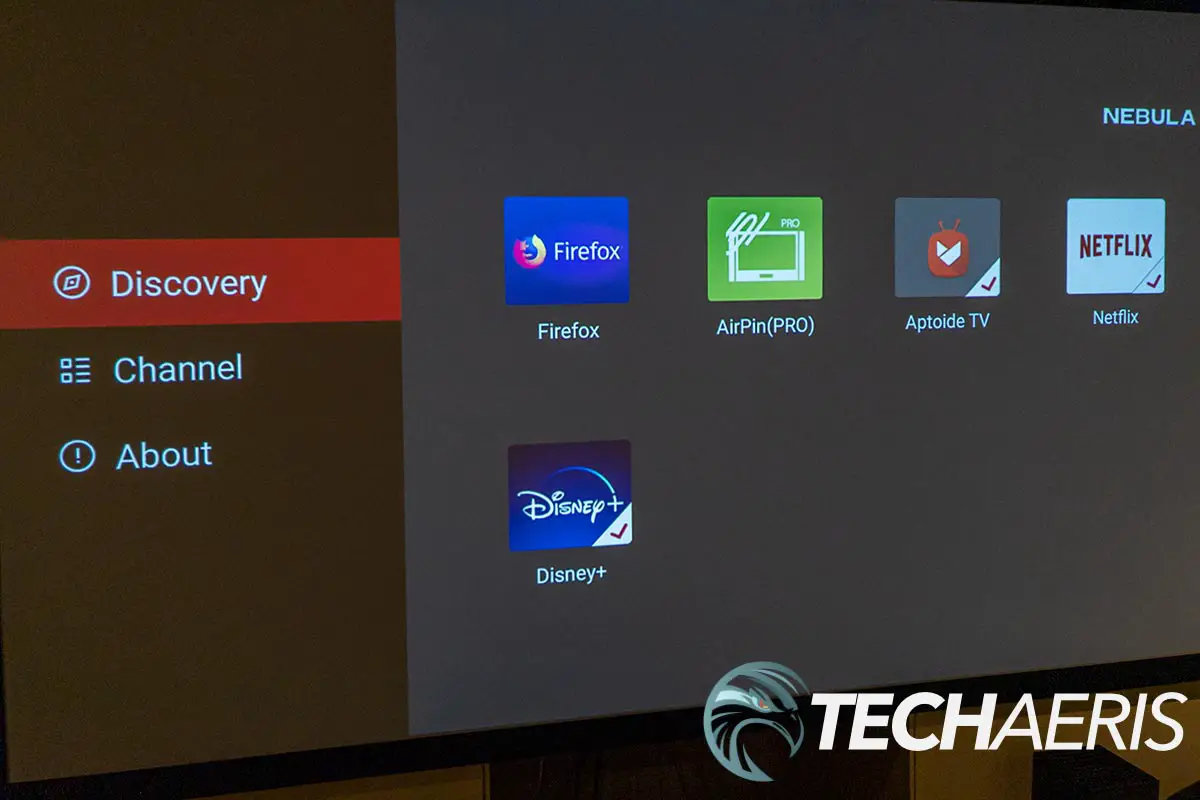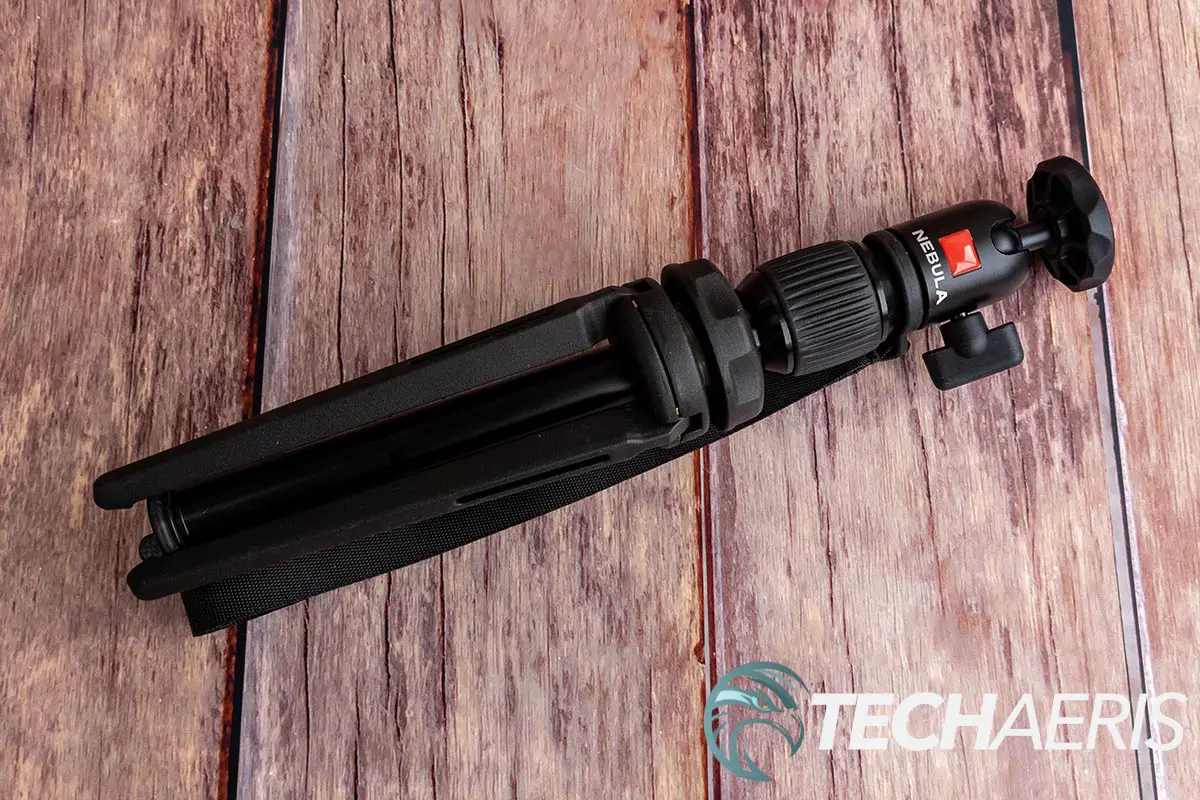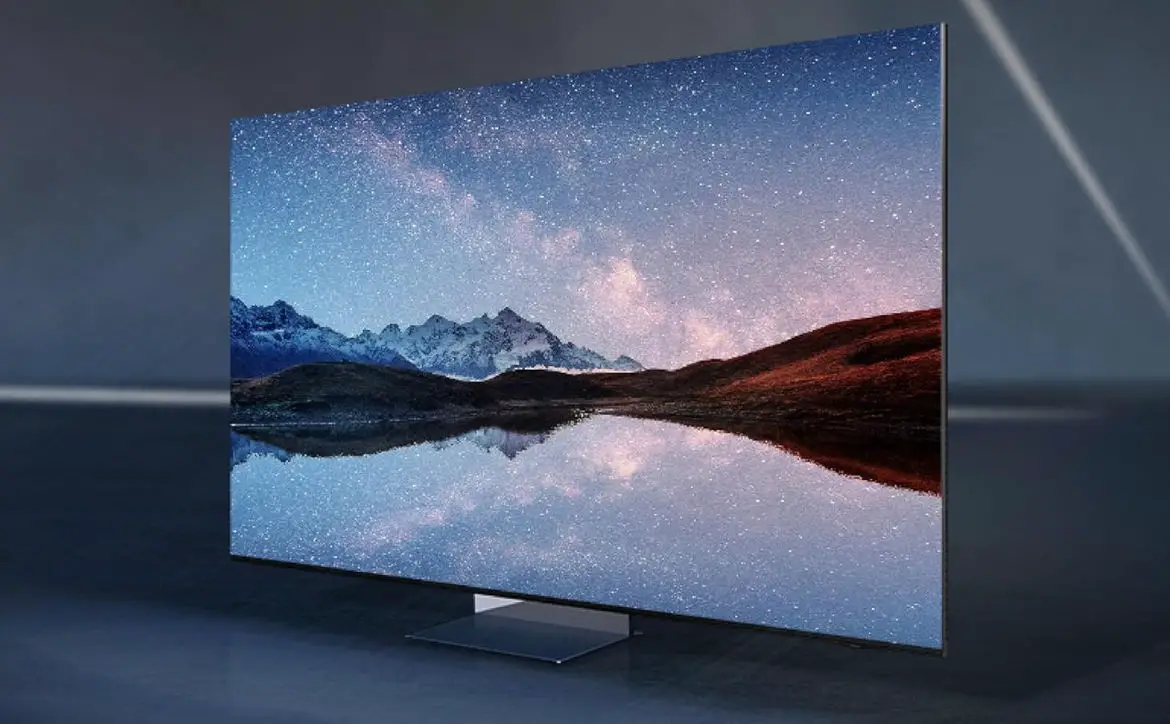
When most people think of projectors, the big, bulky home theatre models come to mind. However, many companies make smaller portable ones as well.
Estimated reading time: 12 minutes
Our Nebula Solar Portable review looks at a small 1080p projector from Anker with 400 ANSI lumens of brightness, a built-in battery, and Android TV on board. Read on for the full review to see how it performs!
Table of contents
Specifications
The Nebular Solar Portable Home Cinema we reviewed has the following features and specifications:
| Model Number | D2131 |
| Display Technology | 0.23DMD in 1080p DLP |
| Native Resolution | 1920×1080 |
| Brightness | 400 ANSI lumens |
| HDR | HDR10 |
| LED Life | 30,000 hours |
| Aspect Ratio | 16:9 |
| Throw Ratio | 120 in @3.18 m; 100 in @2.66 m; 80 in @2.12 m; 60 in @1.6 m; 40 in @1.06 m |
| Focus Adjustment | 3-second autofocus |
| Projection Mode | Front, Rear, Front Ceiling, Rear Ceiling |
| Keystone Correction | Auto (vertical ±40°) Manual (horizontal ±40°, Quadrilateral ±40°) |
| Interface | HDMI 2.0 (up to 4K input), USB-A for flash drives, Type-C for Power Delivery charging, 2.4GHz/5GHz Wi-Fi |
| Controls | Physical power button Touch buttons for volume, mode switch IR/BT remote BT Remote App (Nebula Connect for Android & iOS) |
| CPU | Quad-Core A55 Chipset |
| GPU | Quad-Core Mali G31 |
| RAM | 2GB DDR |
| ROM | 8GB eMMC |
| Battery | 20,000mAh/3.7v (up to 3h) |
| Speaker | 2x 3W with Dolby Digital Plus |
| Video Formats | Supports *.mkv,*.wmv, *.dat, *.avi, *.mov, *.iso, *.mp4, *.rm formats |
| Audio Formats | Supports MP3, WMA, RM, FLAC, Ogg |
| Operating System | Android TV 9.0 with Google Assistant and Chromecast |
| Dimensions | 192.25 x 192 x 58.65mm (7.6 x 7.6 x 2.3in) |
| Weight | 1.4kg (3.09lbs) |
What’s in the box
- Nebular Solar Portable
- Remote w/ 2AAA batteries
- OD Charger
- USB-C to USB-C cable
- Quick Start Guide
- 12-month warranty
Design
Before I get into design, even though the name of the projector is the Nebula Solar Portable, don’t be fooled into thinking it has anything to do with being solar rechargeable. That out of the way…
White in colour, the projector is almost square in shape, just over 7 1/2-inches wide and deep and just over 2 1/4-inches in height. The corners are nicely rounded, giving it an appealing look. The lens is situated on the front beside the autofocus camera, while the ports are on the back. The back is black with a fin design for ventilation. If you look closely, you can see the left and right stereo speakers as well. From left to right, when looking at the back, you’ll find the IR port, HDMI port, Type-C charging port, USB-A port, and the power button.
On the top of the projector, near the front, the Nebula logo is imprinted in red. Towards the back of the projector are three touch buttons. These allow you to adjust the volume up or down and switch between connection modes, including Bluetooth, to use as a speaker for music streaming.
The outer edge on the bottom of the projector has the same fin design as the back for extra ventilation. Two round rubber-like feet sit near the back with a wider rectangular one on the front. The words SOLAR PORTABLE are printed in gloss black on the front foot. At first, I wondered why. As it turns out, this piece can be folded out and forward, allowing you to adjust the projector’s viewing angle by up to 13°. When folded out, the branding is visible when looking at the front of the projector. Finally, a threaded screw mounting hole is centred in the bottom for mounting to a ceiling or optional tripod.
Being a portable projector, it’s not exactly the lightest – coming in around 3lbs. Still, it’s much lighter than your full-sized projectors, so it is easier to take on the go or move around.
The included remote control is relatively slim, measuring about 6 1/4- by 1 1/2- by 3/8-inches. On the top left of the face of the remote is the microphone beside the power button. The buttons on the remote, from top to bottom, allow you to power the projector on and off, toggle autofocus, invoke Google Assistant, move up/down/left/right and OK for navigation, go back, go home, launch the settings menu, and adjust the volume up and down. One thing about the remote is that the rear battery compartment lid is extremely tight and difficult to get off.
Display
The Nebula Solar Portable has a 1080p FHD resolution with HDR support. As far as brightness is concerned, this portable projector offers 400 ANSI lumens. While not the brightest when compared to full-sized home theatre projectors, it is on the upper end of portable projectors. As a result, it’s not very bright but works well enough in a darkened room or basement. Of course, the further away you get, the dimmer the picture, but in a darkened room or basement, it’s adequate.
For most of my testing, I did indeed test it in our basement with a 106″ projector screen. I was able to fill the screen from about 9 feet away. Nebula says you can get a 120″ image from as far as just under 10 1/2 feet away, which is pretty substantial.
Brightness aside, colours were decent enough, and the HDR content I tried on Netflix seemed decent as well. Given the size, portability, and price of the projector, the picture quality is definitely satisfactory.
Setup/Ease of Use
Being an Android TV projector, there is some setup required. Hold the power button on the Nebula Solar Portable down for about two seconds. The projector will power on, auto-focus, and instruct you to hold the OK and Volume Down keys on the remote for about 10 seconds to pair the two together.
Next, select your preferred language. I chose the quick setup mode, which allows you to transfer settings to the projector from your Android phone. To do this, open your Google app on your smartphone and say, “OK, Google, set up my device,” then tap D2130 on the list. Verify the code on your phone matches the one on the projector, and click next. Select your Wi-Fi network, and copy the settings to the projector. Setup then continues on the Solar Portable.
On the projector, accepts the Google Terms of Service. You can then allow or disallow location services, choose to send anonymous diagnostic information to Google to help improve Android, enable Google Assistant, turn on (or disable) personal results, sign up for Google Assistant emails, and install recommended apps such as Spotify or Disney+. One suggested app is the Nebula Manager, which you’ll want to install. Once done, you’ll get a quick overview of Android TV which basically lets you know that you can download apps from the Play Store, use your Google Assistant, and finally, cast content from your Android devices using the built-in Chromecast feature.
Software
Android TV
Android TV is Google’s previous interface for Android-based TVs and projectors. Many devices are getting upgraded with the recently announced Google TV with its updated interface.
As an interface, Android TV still works just fine and is easy to use and navigate. The home screen has customizable rows for apps that show suggested content to the right. The upper right has icons for inputs, battery remaining (if the device runs off battery power), settings, and the time. The settings section lets you adjust everything from system updates to connected devices, projector settings, HDMI, network settings, device preferences, and more. Overall, it’s pretty straightforward and easy to navigate.
Interestingly enough, while you can install most apps from the Google Play Store on the Nebula Solar Portable, Netflix is one you can’t. However, this is an easy fix as one can install it with the Nebula Manager app mentioned previously, which we’ll discuss next.
Nebula Manager
Nebula Manager is another app store/interface for the Solar Portable. It is a must install if you want to use Netflix; otherwise, you can do without. Once you select the Netflix tile within the app, you will be warned that it is a mobile version, and you’ll also need the Nebula Connect smartphone app for easier controls. Click OK, then click to install the Netflix app. Android TV will then prompt you to allow Nebula Manager to install unknown apps. Allow this, press the back button on the remote, then click the install tile again. Netflix will then install.
The Nebula Manager app is pretty basic. It offers three main sections: Discover, Channel, and About. The first suggests a few apps, including Firefox, Aptoide TV, and Netflix. Aptoide TV might be another app you want to install as it gives you access to even more apps than may be available through the Play Store.
Nebula Connect
While you can navigate Netflix without Nebula Connect, it is a bit of a challenging experience. Available from the Play Store, once installed, Nebula Connect pairs your phone to the projector and can be used in mouse or controller mode. Controller mode works great within the Android TV interface and most apps. Mouse mode makes Netflix much easier to use as a cursor appears on the screen and makes it easier to select what you want. You can also control the volume and power of the projector using the app as well.
Performance
The Nebula Solar Portable projector performs quite well. It takes about 3 seconds to power on and focus before you can use it and turns off pretty much instantly. Navigating through the Android TV interface was quick and snappy, and I didn’t notice or experience any lag. The autofocus takes a few seconds but seemed pretty accurate each time it ran.
Sound Quality
With two 3W stereo speakers on board, I wasn’t expecting much considering larger projectors with built-in speakers haven’t sounded the greatest. While there’s not much in the bass department, the projector is quite loud, and I found a volume of about 50% was more than adequate in my basement. For a bit more immersion, 70% was about as high as I wanted to go. Even at full volume, however, the audio was clear and crisp without any noticeable distortion. It was also fuller than I expected due to its Dolby Digital Plus support.
Battery Life
Nebula claims up to 3 hours of battery life on a single charge, which should be enough to get you through most movies. When set to Standard Mode, the projector will stay on maximum brightness and get about 1 1/2 hours of battery life. To get closer to the stated 3 hours, Battery Mode needs to be used. This mode automatically adjusts the brightness to hit that mark. During testing, I hit close to 1 1/2 and 3 hours, depending on the mode used and with the volume set to about 50%.
Accessories
Anker sent over an adjustable tripod as well (not included). While designed for the Nebula Capsule projector, it does work for the Solar lineup just as well. Pretty standard fare, the aluminum tripod is solidly constructed. It’s also lightweight, weighing only 9.5oz, and comes with a carry strap attached to it.
The three bottom legs can be adjusted by way of a ring just above them. Another adjustable ring sits just under 4-inches above this, allowing for further height adjustment. Users can adjust the tripod from between 10.2 and 15.7-inches in total. Finally, the top mounting plate, which screws into the bottom of the projector, can rotate a full 360° and tilts 90° in either direction for 180° of tilt.
With an MSRP of US$47.99, the price is in line with similar-sized tripods on the market and sturdy to boot. You can also get a carry case for the projector for $49.99. Unfortunately, we didn’t get a chance to try it out but given the tripod’s quality and the projector, and I’d expect to see something similar for the case.
Price/Value
With a retail price of US$599.99, the Nebula Solar Portable isn’t exactly cheap. Portable projectors are an interesting bunch when it comes to price, with some available for as low as $100. However, the specifications are usually worded in such a way that you may not always be getting what’s advertised on the surface. If you want to go even a bit cheaper, you can get the Nebula Solar — the same projector without the battery — for $519.99.
With the Solar Portable, you are getting a true 1080p HD projector with Android TV. It is also currently on sale for $569.99, so that does save you a few dollars if you’re looking to pick one up.
Photo Gallery
Wrap-up
I was pretty impressed with the Nebula Solar Portable, given its size. With a full 1080p picture, fairly decent sound, a battery for short on-the-go viewing, and Android TV, this portable projector has just about everything you need.
In some of our articles and especially in our reviews, you will find Amazon or other affiliate links. As Amazon Associates, we earn from qualifying purchases. Any other purchases you make through these links often result in a small amount being earned for the site and/or our writers. Techaeris often covers brand press releases. Doing this does not constitute an endorsement of any product or service by Techaeris. We provide the press release information for our audience to be informed and make their own decision on a purchase or not. Only our reviews are an endorsement or lack thereof. For more information, you can read our full disclaimer.
Last Updated on June 6, 2021.


